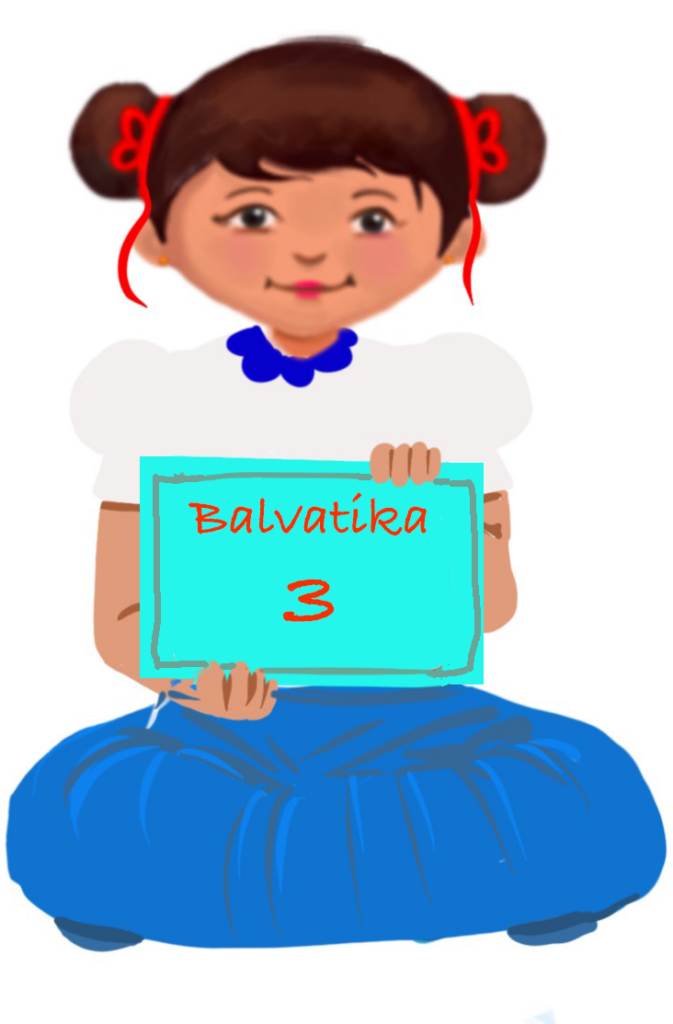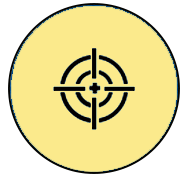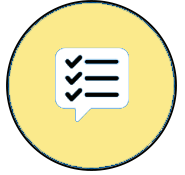
Comparing Objects
Week 2 – Empty or Full
Learning Outcome
Recognises the presence and absence of objects/things and uses vocabulary like full and empty.
 Objective
Objective
Children will learn to use the vocabulary for opposite words like “empty” and “full” in the context of different objects around them.
 Prerequisites
Prerequisites
- Identify different items around them.
- The teacher can have a simple check for the child’s ability to distinguish objects by showing them different objects available in the classroom and asking them to identify the objects based on some criteria or do a simple sorting.
Introduction – Empty or Full
Resources required:
- A glass, water bottle and two glass or transparent containers.
- Solid materials such as rice, beans, etc.
Introduce the term ’empty and full’:
- The teacher can introduce the concepts ‘empty and full’ by showing a glass full of water and then slowly emptying it into the jug.
- The teacher says, ‘The glass is empty’.
- The teacher can now fill the glass or water bottle with water and show the children and say, “Now the glass/water bottle is full.” Ask the children to repeat “full” after the teacher.
- The teacher can further ask children, “Can you fill this with more water?”
- The teacher asks the children what will happen if we keep pouring water into a full glass and may demonstrate this.
- The teacher can now place a glass filled with water and an empty/half/quarter full glass side by side and ask children by pointing to one of them, “Children, raise (or clap) your hand if this is full.”
- The teacher can now repeat the same with rice/beans and a glass container.
- The teacher can randomly call the children and ask them whether the glass/container is empty, and if it is empty, help them to fill it with water, rice, or beans
- A video can be shown to reinforce the concept of empty and full.
Refer to ‘Receptive and Expressive language skills’ Adaptations and Strategies given in the Main page of ‘Comparing Objects’ if there are any neuro-diverse children in the class.
Vocabulary cards: Empty and full
Flashcards: Empty and full
Poster: Empty and full
Video: Introduction to empty and full
ISL Video: Introduction to empty and full
Activity 1: Fill it up, Empty it out!
Objective:
To identify “empty” and “full” baskets through tactile activity.
Importance of the activity for children:
Helps in developing:
- Gross motor skills (holding and passing the baskets, coordination between hand movements)
- Fine motor skills (Placing objects into and removing objects from the basket, hand eye coordination, clapping)
- Cognitive skills (association, connecting and grasping the idea of volume and capacity)
- Sensory perception skills (differentiating between empty and full)
- Social skills (cooperation, playing together)
- Emotional skills (sense of achievement on completion builds self-esteem)
- Vocabulary skills (full and empty)
Resources required:
- Empty basket
- Variety of common objects such as blocks and toys.
Setting for the activity:
The activity can be done indoors or outdoors, depending on the availability of space.
Type of activity: Group activity
Preparation of activity:
1. Place an empty basket and the objects within reach of children.
2. Children to sit in a circle.
Role of the teacher: Demonstrator and facilitator
Procedure:
- The teacher hands over the empty basket to one of the children.
- The child has to put an object in it and pass it on to the next child.
- This repeats until the basket is full.
- The child who puts the last object in it claps and says “Full.”
- The next child empties the basket and says “Empty” before passing it on to the next child.
Observation:
The children are made to observe the result of the activity as follows:
- The teacher can ensure that the children fill the basket to its capacity while clapping ‘Full.’
- Similarly, the teacher can ensure that the child empties it completely while saying ‘Empty.’
The teacher can note down his or her observations and guide the children accordingly. For example, if the child is still confused as to whether to put the object in the basket, the teacher can help the child by demonstrating.
Suggested variation in the activity:
- Instead of any common objects, children can be given objects that fit a theme. For example, one round can be all red objects, another round can be all animal toys, etc.
- The teacher can attach numbers to each object and have children place objects in the basket in numerical order. For example, as each child places an object into the basket, they say the number aloud. The child who places the final object says “Full” and the total number of objects. The next child empties the basket, counts all objects as they remove them, and says “Empty.” [Maximum 10 objects can be kept]
- The teacher can begin with a story. Each child adds an object to the basket and contributes to the story. As each child adds an object, they must include that object in a sentence to continue the story. The child who places the last object concludes the story with “Full.” The next child begins a new story while emptying the basket.
Conclusion:
Children would learn to identify ’empty’ and ‘full’ objects.
Refer to ‘Visuospatial skills’ Adaptations and Strategies given in the Main page of ‘Comparing Objects’ if there are any neuro-diverse children in the class.
Video: Fill it up, empty it out!
ISL Video: Fill it up, empty it out!
Activity 2: Full or Empty? Sorting Fun!
Objective:
To sort objects as empty and full in a play-by-play method.
Importance of the activity for children:
Helps in developing:
- Gross motor skills (sorting and placing objects, coordination between hand movements)
- Fine motor skills (picking and placing objects, hand eye coordination)
- Cognitive skills (observation and reasoning)
- Sensory perception skills (differentiating between empty and full)
- Social skills (cooperation, playing together)
- Emotional skills (sense of achievement on completion builds self-esteem)
- Vocabulary skills (full and empty)
Resources required:
- A set of objects/pictures that can be categorized as empty or full, such as empty and filled water bottles, empty and filled snack bags, or empty and filled jars.
- Chart paper with Empty and Full written on it.
Setting for the activity:
The activity can be done indoors or outdoors, depending on the availability of space.
Type of activity:
Can be done as an Individual or group activity.
Preparation of activity:
1. The teacher is to provide objects that are empty and full for each group.
2. A table with a labels ‘Empty’ and ‘Full” or two sections marked on the floor as ‘Empty’ and ‘Full’ should be kept ready.
Role of the teacher: Demonstrator and facilitator
Procedure:
- The teacher may start by showing the empty and full objects. The teacher can further explain that in this activity we are going to place the empty objects on one side and full objects on the other side.
- The teacher may pick up an object and ask the children to tell if it is empty or full. For example, the teacher picks up an empty glass and places it in the empty section.
- The teacher may keep a few boxes that are not completely full. Children should not sort them.
- The same act may be repeated with full objects to make the children familiar with the activity.
- Each group/individual sorts the objects given to them.
Observation:
The children are made to observe the result of the activity as follows:
- The teacher may show the empty objects to the children and tell them that all the empty objects have been collected in the empty section.
- Then the children may be asked where the full objects are collected. The answer may be given after eliciting the response from them, saying, “Yes, we have collected all the full objects in the full section.”
- The teacher may write their observations and challenges to give feedback.
Suggested variation in the activity:
- The teacher can keep a few full bags and a few empty bags. The children can hold them and guess if they are full or empty before looking at them.
- The teacher can start a story where children have to sort objects to progress in the narrative. For example, “The hungry bear wants a full jar of honey. Can you find the full jar for the bear?”
Conclusion:
Children would learn to classify objects as empty and full.
Refer to ‘Fine motor skills’ Adaptations and Strategies given in the Main page of ‘Comparing Objects’ if there are any neuro-diverse children in the class.
Video: Full or empty? Sorting fun!
ISL Video: Full or empty? Sorting fun!
Activity 3: Fill Your Crate and Clear it all
Objective:
To understand the terms ‘Full’ and ‘Empty’ through Nature Walk.
Importance of the activity for children:
Helps in developing:
- Gross motor skills (Walking, bending and placing objects, coordination between hand movements)
- Fine motor skills (picking and placing objects, hand eye coordination)
- Cognitive skills (focus, observation, attention for details, alertness)
- Physical fitness (boosts muscle power and endurance)
- Sensory perception skills (differentiating between empty and full)
- Social skills (cooperation, playing together)
- Emotional skills (sense of achievement on completion builds self-esteem)
- Vocabulary skills (full and empty)
Resources required:
- Empty containers
- Naturally available objects such as leaves, stones etc.
Setting for the activity: Outdoor activity
Type of activity: Individual or Group
Preparation of activity:
Provide empty containers for each group/individual.
Role of the teacher: Demonstrator and facilitator
Procedure:
- The teacher may start by filling up an empty container with natural objects like stones, leaves etc. The teacher can further explain that in this activity we are going to fill the containers with different objects from nature.
- Each group/individual is given an empty container.
- Encourage the children to fill the empty container with the maximum number of different objects from the surrounding natural environment.
Observation:
The children are made to observe the result of the activity as follows:
- The teacher may show them a full container and the different objects collected.
- Help them understand that when the container is empty, it means there is nothing inside, and when it is full, it means it is holding as much as it can.
The teacher may write their observations and challenges to give feedback.
Suggested variation in the activity:
- Children can use a water can to fill water and water the plants and make the can empty.
- Collect only flowers in the container to use them later to make a garland.
- Children fill bird feeders with birdseed, observing when the feeders are full. They watch as birds eat the seeds, eventually emptying the feeders.
Conclusion:
Children would learn to identify empty and full.
Refer to ‘Organisational skills’ Adaptations and Strategies given in the Main page of ‘Comparing objects’ if there are any neuro-diverse children in the class.
Assessment
The teacher can give the assessment worksheet at the end of the lesson.
Resources required: Worksheet
Practice Worksheet: Full or Empty
Practice Worksheet: Full or Empty (Enlarged)
Assessment Worksheet: Full or Empty
Assessment Worksheet: Full or Empty (Enlarged)
Home Activity: Full or Empty
Objective:
To reinforce the concept of ‘Full or Empty’ by comparing objects through an online fun activity.
Fun Activity: Quiz – Full or empty

Cross-Curricular Connection:
- In Art and Craft class:
- Children can draw and show empty and full basket. (Can draw fruits or vegetables)
- In Language class:
- Use words like ‘half’, ‘full’ or nearly full.
- In Music class:
- Teaching songs and rhymes on full and empty.
Check list for teacher:
| Activity | Yes | No | Sometimes |
| Children can: | |||
| Comprehend and use the terms empty and full in the context of different objects around them | |||
| Identify and sort empty and full objects | |||
| Relate the terms empty and full in real life situations | |||
| Explore and appreciate the natural surrounding | |||
| Focus on the activity | |||
| Complete the activity in the given time | |||
| Do the activity independently | |||
| Express verbally and through actions, expressions or gestures |
Teacher Resource Document
| Source and Attribution of images: All images used in the above Assets and Aids are originally created. |
| This digital material has been developed by the Sri Sathya Sai Vidya Vahini Inclusive Education Project, a unit of Sri Sathya Sai Central Trust, Prasanthi Nilayam, as a collaborative offering in the service of our nation. |